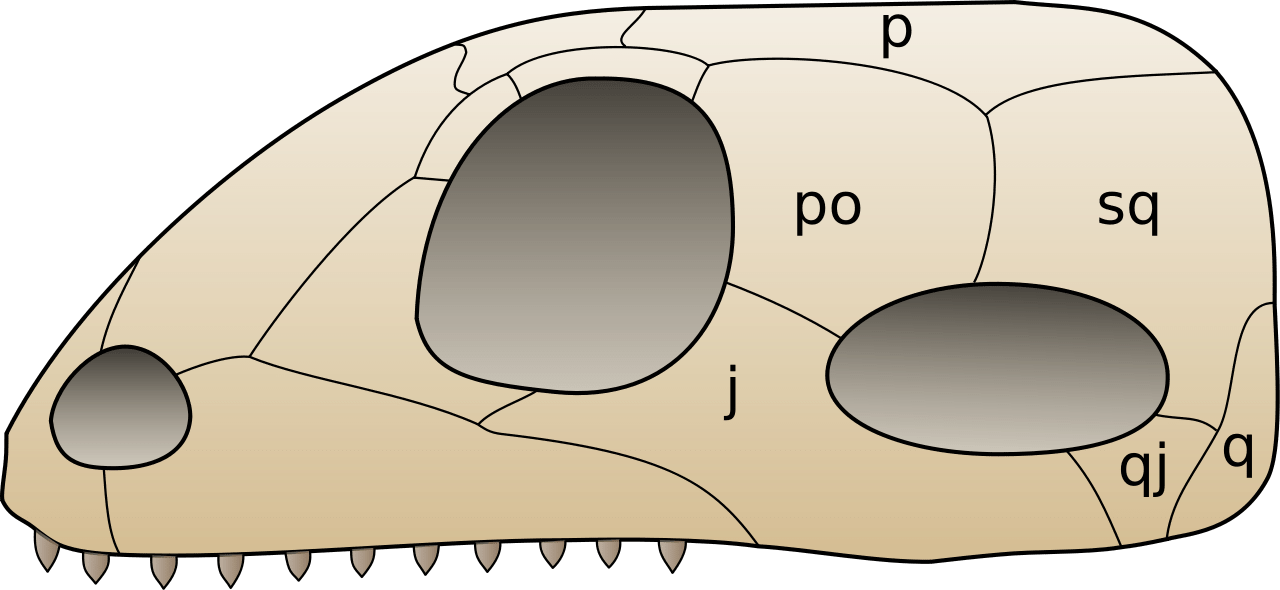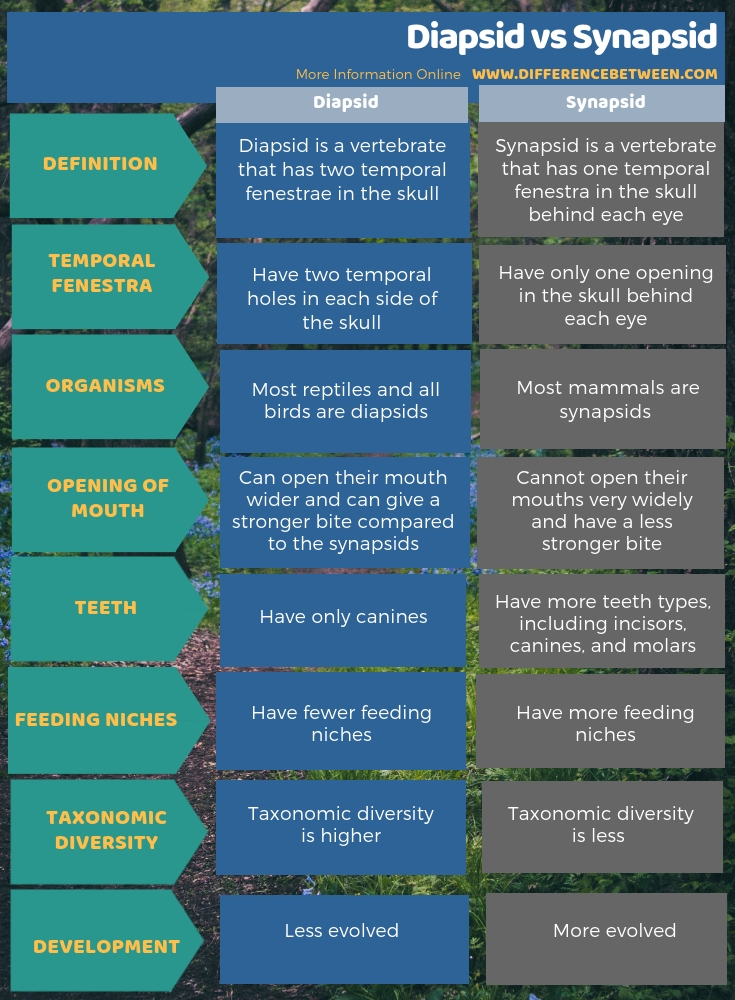Difference Between Diapsid and Synapsid
The key difference between diapsid and synapsid is that diapsid is a vertebrate that possesses two major holes known as temporal fenestrae in their skull, while synapsid is a vertebrate that possesses only one hole in each side of their skull around the temporal bone.
Diapsids and synapsids are two groups of the amniotic clade that include chordates. Amniotes have a temporal region in the skull that can either be solid or have openings. The major between diapsid and synapsid is the number of openings or holes (temporal fenestrae) present in the skull behind each eye. Diapsid has two temporal fenestrae in the skull while synapsid has one temporal fenestra in the skull behind each eye. Most reptiles and all birds are diapsids whereas most mammals are synapsids.
CONTENTS
1. Overview and Key Difference
2. What is Diapsid
3. What is Synapsid
4. Similarities Between Diapsid and Synapsid
5. Side by Side Comparison –Diapsid vs Synapsid in Tabular Form
6. Summary
What is Diapsid?
A diapsid is any vertebrate with two major holes known as temporal fenestrae in their skull. The earliest known diapsid lived on the Earth about 300 million years ago. Most reptiles and birds belong to the group of diapsids, as they have two temporal holes in their skull. There are more than 14,600 extant species of birds and reptiles included in diapsids. That means; they are an extremely diversified group of animals, including crocodiles, lizards, snakes, tuatara, and birds. However, lizards and snakes have only one temporal hole in the skull, but their ancestors had two.

Figure 01: Diapsid Skull
In addition, birds have a heavily restructured and modernized skull. Those birds, along with snakes and lizards, still come under the category of diapsids as their ancestors had two temporal fenestrae. These all-important holes are at both sides of the skull, above and below the eye, which gives a count of four as two from each side.
The importance of this bone arrangement is that it allows for a firm and strong muscle attachment. Therefore, the jaw muscles can provide a super powerful bite from a widely opened mouth. Crocodiles would be the best example to explain the diapsid arrangement of the skull bones and its necessity for a predatory life. Extinct animals such as dinosaurs, pterosaurs, plesiosaurs, etc. were also diapsids. According to the ancestral skulls of the diapsids, the lower arm bone was longer than the upper arm bone of the holes.
What is Synapsid?
Literally, the term synapsid means fused arch, and synapsids are a group of animals (vertebrates) including all the mammals and few other mammal-like reptiles. The distinguishing feature of synapsids is the presence of only one hole in each side of their skull around the temporal bone, which accounts for two holes in total. Synapsids have special types of teeth known as incisors, canines, and molars. The presence of different types of teeth has allowed these animals to be more versatile in feeding behaviours. Therefore, the ecological influences in feeding have been diversified across synapsids.

Figure 02: Synapsid Skull
The metabolism, presence of hair on the skin, and many other mammalian characteristics are also present among present-day synapsids. However, synapsids have originated among reptiles, and with time, it became more mammalian and less reptilian.
What are the Similarities Between Diapsid and Synapsid?
- Diapsids and synapsids are two groups of the amniotic clade.
- These two groups separate from each other from the number of holes (temporal fenestrae) present in the skull behind each eye.
- Both groups constitute chordates.
What is the Difference Between Diapsid and Synapsid?
Diapsid is a vertebrate that possesses two major holes known as temporal fenestrae in their skull while synapsid is a vertebrate that possesses only one hole in each side of their skull around the temporal bone. So, this is the key difference between diapsid and synapsid. Most reptiles and all the birds are diapsids while most mammals are synapsids.
Moreover, the diapsids can open their mouth wider and can give a stronger bite compared to the synapsids. Therefore, this is also a difference between diapsid and synapsid. Besides, one other significant difference between diapsid and synapsid is in their teeth types. Diapsids have only canines while synapsids have more teeth types, including incisors, canines, and molars. Additionally, a further difference between diapsid and synapsid is that the synapsids have more feeding niches than diapsids. But, taxonomic diversity is higher among diapsids than in synapsids.

Summary – Diapsid vs Synapsid
Amniotes have a temporal region in the skull which can either be solid or have openings called temporal fenestrae. Based on that, there are three groups of amniotes, as anapsids, synapsids and diapsids. Anapsids have no temporal fenestrae. Synapsids have one temporal fenestra behind each eye. On the other hand, diapsids have two temporal fenestrate behind each eye. So, this is the key difference between diapsid and synapsid.
Reference:
1. “Synapsid.” Wikipedia, Wikimedia Foundation, 28 June 2018, Available here.
2. “Diapsid.” Wikipedia, Wikimedia Foundation, 9 May 2019, Available here.
Image Courtesy:
1. “Skull diapsida 1” By derivative work: Gagea (talk)Skull_diapsida_1.png: Preto(m) – Skull_diapsida_1.png (CC BY-SA 3.0) via Commons Wikimedia
2. “Skull synapsida 1″By derivative work: Gagea (talk)Skull_synapsida_1.png: Preto(m) – Skull_synapsida_1.png (CC BY-SA 3.0) via Commons Wikimedia
ncG1vNJzZmivp6x7pbXFn5yrnZ6YsqOx07CcnqZemLyue8OinZ%2Bdopq7pLGMm5ytr5Wau26wyJqnrKGUYq6vsIyvqmarqaOusb%2FInWY%3D